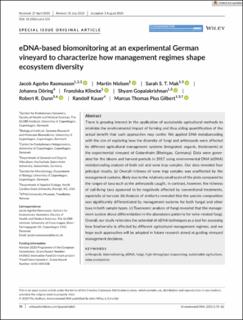| dc.contributor.author | Agerbo Rasmussen, Jacob | |
| dc.contributor.author | Nielsen, Martin | |
| dc.contributor.author | Mak, Sarah Siu Tze | |
| dc.contributor.author | Döring, Johanna | |
| dc.contributor.author | Klincke, Franziska | |
| dc.contributor.author | Gopalakrishnan, Shyam | |
| dc.contributor.author | Dunn, Robert R. | |
| dc.contributor.author | Kauer, Randolf | |
| dc.contributor.author | Gilbert, Marcus Thomas Pius | |
| dc.date.accessioned | 2022-02-28T15:00:48Z | |
| dc.date.available | 2022-02-28T15:00:48Z | |
| dc.date.created | 2021-09-23T12:48:24Z | |
| dc.date.issued | 2021 | |
| dc.identifier.citation | Environmental DNA. 2021, 3 (1), 70-82. | en_US |
| dc.identifier.issn | 2637-4943 | |
| dc.identifier.uri | https://hdl.handle.net/11250/2981839 | |
| dc.description.abstract | There is growing interest in the application of sustainable agricultural methods to minimize the environmental impact of farming and thus aiding quantification of the actual benefit that such approaches may confer. We applied DNA metabarcoding with the aim of exploring how the diversity of fungi and arthropods were affected by different agricultural management systems (integrated, organic, biodynamic) at the experimental vineyard of Geisenheim (Rheingau, Germany). Data were generated for the bloom and harvest periods in 2017, using environmental DNA (eDNA) metabarcoding analysis of both soil and vane trap samples. Our data revealed four principal results. (a) Overall richness of vane trap samples was unaffected by the management systems, likely due to the relatively small scale of the plots compared to the ranges of taxa such as the arthropods caught. In contrast, however, the richness of soil-living taxa appeared to be negatively affected by conventional treatments, especially at harvest. (b) Analysis of similarity revealed that the species composition was significantly differentiated by management systems for both fungal and other taxa in both sample types. (c) Taxonomic analysis of fungi revealed that the management system drove differentiation in the abundance patterns for wine-related fungi. Overall, our study reiterates the potential of eDNA techniques as a tool for assessing how biodiversity is affected by different agricultural management regimes, and we hope such approaches will be adopted in future research aimed at guiding vineyard management decisions. | en_US |
| dc.language.iso | eng | en_US |
| dc.publisher | Wiley | en_US |
| dc.rights | Navngivelse 4.0 Internasjonal | * |
| dc.rights.uri | http://creativecommons.org/licenses/by/4.0/deed.no | * |
| dc.title | eDNA-based biomonitoring at an experimental German vineyard to characterize how management regimes shape ecosystem diversity | en_US |
| dc.type | Peer reviewed | en_US |
| dc.type | Journal article | en_US |
| dc.description.version | publishedVersion | en_US |
| dc.source.pagenumber | 70-82 | en_US |
| dc.source.volume | 3 | en_US |
| dc.source.journal | Environmental DNA | en_US |
| dc.source.issue | 1 | en_US |
| dc.identifier.doi | 10.1002/edn3.131 | |
| dc.identifier.cristin | 1937613 | |
| cristin.ispublished | true | |
| cristin.fulltext | original | |
| cristin.qualitycode | 1 | |

